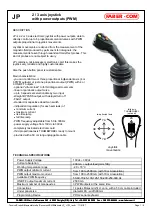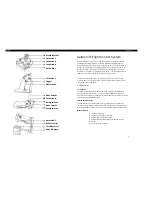
6/14
Figure 19. Manual Override.
Dual Auxiliary Switch Setting
For DA-044N024FX2XP, DA-044N024PA2XP, DA-044N024PX2XP
only.
Factory setting:
-
A = 5°
-
B = 85°
Use a flat-blade screwdriver to adjust the A switch. The long arm of the
†
points to the setting. Manually turn the red ring of the B switch. The
narrower tab on the ring points to the setting. See Figure 20.
The auxiliary switch setting shafts rotate with the actuator.
The scale is valid only when the actuator is in the "0" position on
clockwise motion.
Figure 20. Auxiliary Switch Setting Dial.
Mechanical Range Adjustment
1. Loosen the stop set screw.
2. Move it along the track to the desired position, and fasten it in
place.
Figure 21. Moving the Mechanical Range Stop.
To use the entire 0 to 10V input signal to control the mechanically
limited range, see Figure 16 for setting self-adaptive features.
Example:
Stop set screw at 70°
Self-adapt switch ON
Input signal Y = 5 Vdc
The damper will be at 35° (50% of the adjusted range.)
Note:
On versions with the slope and offset features, this example
assumes
-
Offset Uo = 0 Vdc
-
Slope
U = 10 Vdc
Mechanical Range Limitation and
Self
–Adapt Feature
1. To use the entire 0 to 10V input signal to control the adjusted range,
raise the tab located on the lower left-hand side of the actuator and
locate the DIP switches. See Figure 22.
2. Set the self-adapt DIP switch to
(ON).
3. Close the tab over the DIP switches.
For example, if you set the locking screw at 70° and turn the self-adapt
switch ON, a 5V input signal will drive the damper to 35° (50% of its
adjusted range).
Factory setting 0 (OFF)
Figure 22. Self-adapt Switch in the On Position.
When turning the self-adaptive feature on, or after software
reset with the feature on, the actuator will enter a five-minute
calibration cycle as the actuator adjusts to the rotation limits
of the system. The software reset happens after power on,
or may be caused by electrostatic discharge (ESD) at levels
of 2 kV and above.
1
2
































